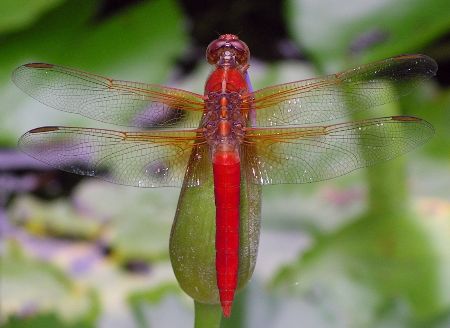by Valerie
June, 2005Neon Skimmer Our subject this month is the stunning neon skimmer (Libellula croceipennis). These dragonflies appeared in our yard shortly after we installed the first pond. They have remained the dominant species ever since and lay eggs in both ponds as well as sometimes in a shallow dish that we try to keep filled. There are over 20 species belonging to the genus Libellula in North America. They are also called the King Skimmers. The neon skimmer is a typical example, being robust, large, fast, aggressive, and colorful. Dragonflies have aquatic larvae, which is why the ponds attract them. The larvae, or nymphs, are top predators when there are no fish, and eat just about anything that is small enough for them to catch. They do an admirable job of controlling mosquitoes, which they capture by using a unique lower jaw mechanism that shoots forward to grasp prey. The larvae usually just walk about on the bottom or on vegetation, but are also able to swim using water pumped quickly out the anus for propulsion. This is possible because the nymph's gills are located within the body cavity and water is constantly drawn in and out of the anus to aerate them. It is sort of like jetting around by sneezing out the wrong end. When the larvae are mature, they must leave the water and will shed their skin, emerging as winged adults. Many species of dragonfly are not really sexually mature at that point, but take a few more days to develop before they can mate. In the interim, their colors often change, sometimes dramatically. The neon skimmers in our yard are usually males, which watch from favorite vantage points and defend territories (the ponds), chasing off all intruders. They have attacked me if I wear a red shirt, and will buzz the dog when she gets a drink. Ruby-throated hummingbirds and the neon skimmers sometimes chase each other, at times all the way around our house. The funny thing about this is that each animal is defending a different resource; the dragonfly wants the pond and the bird wants the flowers in the nearby gardens. All the energy exerted by the males is for one purpose: to mate with the golden-brown females that find the ponds to their liking. These dragonflies mate while flying. Then the male hangs around as the female deposits eggs in the water. She makes scores of circular motions, dipping her tail into the water each time and laying an egg. Whenever she does this, a drop of water is sent flying. It sometimes lands in the water and sometimes out of the pond. If it does hit the water, it has the effect of occasionally luring the fish from the actual egg, which then floats safely down into the water plants. Most of the time, though, the fish simply eat each egg. The dragonflies do change position quite often, which gives a slightly better chance that some eggs will go undetected. Of course, the eggs laid in a small dish are safe from fish, so there are usually a fair number of nymphs in that water. Neon skimmers start to appear in May and can usually be seen all summer long. They add a delightful spot of color to the gardens, as lovely as any flower. |
(More information on the Neon Skimmer is available in "larvalbug's garden.")